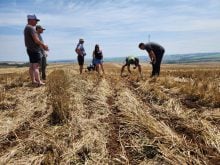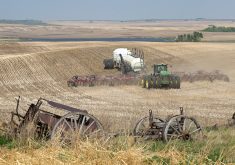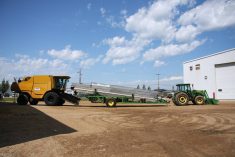Co-operation and an inventive spirit were the inspiration for southern Alberta ranchers as they restored a meandering creek that flows through their property west of Claresholm.
The Lyndon Creek Conservation Partnership consists of Jack and Merry Vandervalk, Gerald and Patricia Vandervalk, Wayne and Judy Lucas and David and Lisa Baptie, who have a long-term goal to raise beef and protect the land and water that feeds them.
“We got involved because we love the land and we want to save the watershed and keep everything relatively natural,” said Wayne Lucas, who has ranched in the area for 35 years.
Read Also

Stacking Canada up on gene editing livestock
Canada may want to gauge how Argentina and other countries have approached gene editing in livestock and what that has meant for local innovation.
Lyndon Creek links to other small streams in the area that eventually join the Oldman River, which flows into the South Saskatchewan River.
The ranchers worked with provincial and federal agencies to conduct riparian health assessments on their share of river front property and then using their own inventiveness, they built fences, installed water troughs and reconstructed creek banks.
Jeff Porter of the Alberta Conservation Association, who works closely with ranchers in three southern rural municipalities, said the assessment provides a baseline of what is there and what is needed for improvement.
The Lyndon Creek ranchers started work in 2002 and have seen substantial improvements by controlling grazing, adding fences and delivering water to cattle.
“You get together as a group of landowners, it opens up more funding for you and with that you can access things like wind shelters,” Porter said.
Other infrastructure costs, such as for fencing, can be covered by a group rather than by attempting to do stewardship projects alone.
The area has been ranched since the 19th century, when people such as entrepreneur Patrick Burns owned large stretches of land. Over the years, the ranches were split into smaller holdings and erosion and grazing pressure occurred. There are also major recreation and industrial pressures on the watershed.
Crowds from Calgary and Lethbridge turn out every weekend with four-wheel-drive and all-terrain vehicles for mud bogging and other activities without realizing how much damage is done to the creek beds.
Logging also causes erosion and adds silt to the creeks because flood waters quickly move through cut blocks.
For the ranchers, restoration involved trial and error along with many successes.
The Vandervalks worked for 10 years with the riparian group Cows and Fish to fence off creeks, install cattle waterers and plan grazing systems. They use some of their riparian areas for short-term, two to three day grazing before moving cattle to other paddocks.
Gerald Vandervalk said part of their plan is to preserve native grasses for grazing starting in September.
A major project to install off-site water troughs turned into a sideline business that finds large, used industrial tires and converts them to troughs with fitted pipes to deliver water from springs and the creek.
Wayne Lucas worked with them to install troughs on his property. Much of his water comes from natural springs that are diverted to the troughs and for home use through a network of pipelines.
Previously, a portion of the creek was diverted throgh culverts under an access road, but a flood in 2005 washed them away. When it came time to repair the damage, the federal department of fisheries and oceans said culverts were unsuitable for fish. Lucas built a bridge instead to open up the creek and improve drainage
Banks rebuilt
Dave Baptie has also done considerable work on his portion of the creek, which uses a permanent fence on one side and electric wires on the other bank.
He also has solar powered off-stream watering for his cattle and worked with Porter to rebuild badly eroded stream banks.
Thigh high sedge grass now grows, as well as willows and poplars planted with a technique called bioengineering. A hole is dug and a length of tree stick is pounded into the ground. About two thirds of the stick is buried and the top sprouts new leaves. The poplars were collected when the Vandervalks were trimming trees in their yard. The sticks were soaked for two days and then planted. Most have sprouted in the course of one season.
“I don’t think any of us thought when we were pounding these sticks in the ground that they were actually going to make a tree,” Baptie said.
Dogwood, saskatoon bushes and willows are among the trees and bushes planted in these projects to stabilize banks. Porter advises using whatever trees are available locally because they are already adapted to the area.
Another technique, called wattle fencing, shored up one side of the bank in a series of terraces held in place with living willow sticks and wire. As the willow grows, the roots spread and hold the bank together like rebar.
Baptie has been working on riparian projects for nine years to clean up the water and provide him with extra pasture.
His carrying capacity has increased since he embarked on these conservation projects.
When projects of this kind started, fences were taken closer to the banks to create a narrow green band. Now a wider area is created, Porter said. The plan is not to fence off every creek in the province, he added.
As well, natural crossing areas can be included rather than letting livestock drink directly from the creek or feeding them on the ice in winter.
Hills and wide treed valleys abound in the foothills and many ranchers like to move cattle into those spots for the shelter.
However, cattle can do considerable damage to the environment as spring approaches. Land is soft and boggy with higher water levels and it does not take long for cattle to chew up new growth and trample stream banks.















